Employee Motivation and Organizational Behavior
VerifiedAdded on 2020/10/05
|17
|4828
|431
AI Summary
This assignment delves into various employee motivation theories, such as Maslow's Hierarchy of Needs, Herzberg's Two-Factor Theory, Vroom's Expectancy Theory, and others. It also touches upon the significance of team development and organizational behavior in a work environment. The assignment is likely to be found on Desklib, which offers best past papers and solved assignments for students seeking academic support.
Contribute Materials
Your contribution can guide someone’s learning journey. Share your
documents today.
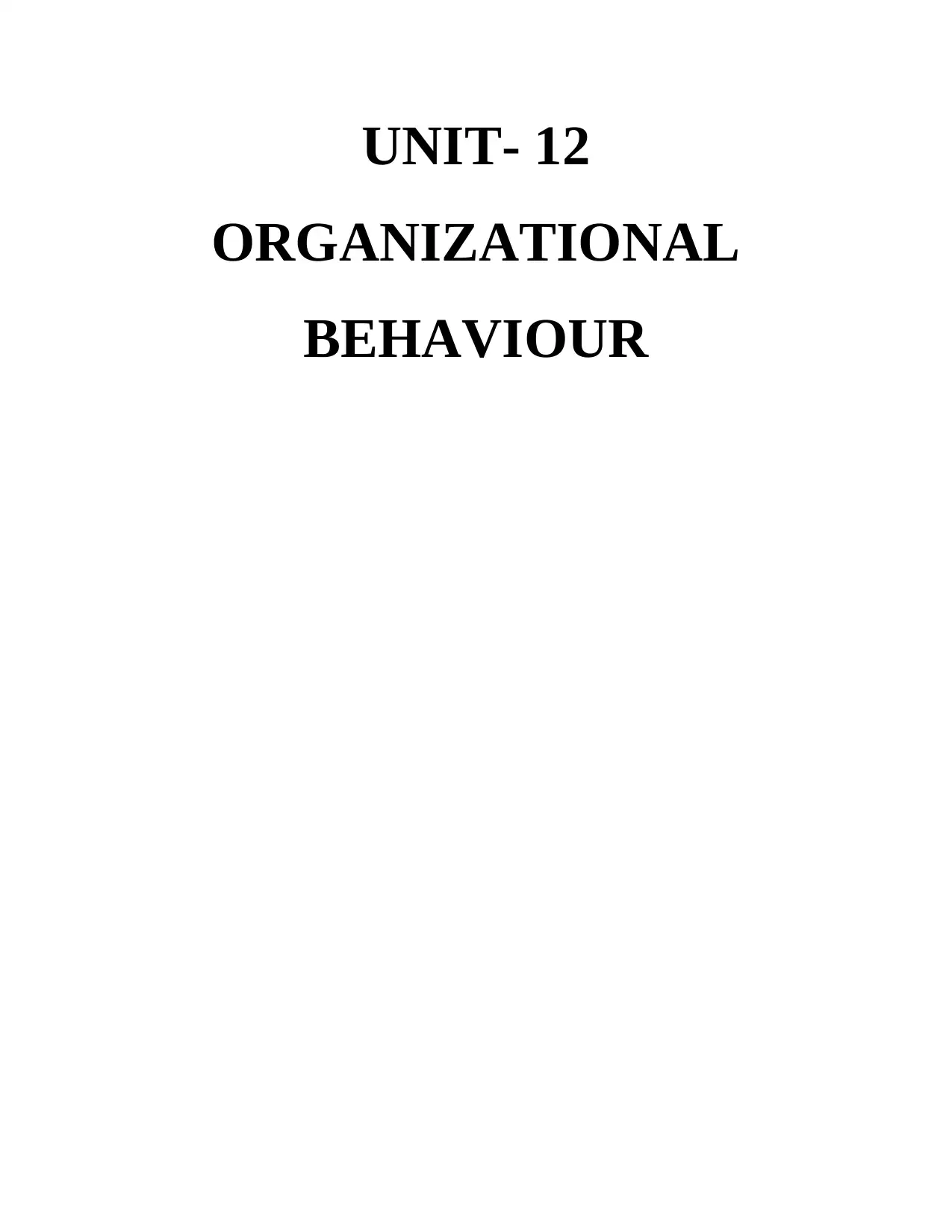
UNIT- 12
ORGANIZATIONAL
BEHAVIOUR
ORGANIZATIONAL
BEHAVIOUR
Secure Best Marks with AI Grader
Need help grading? Try our AI Grader for instant feedback on your assignments.
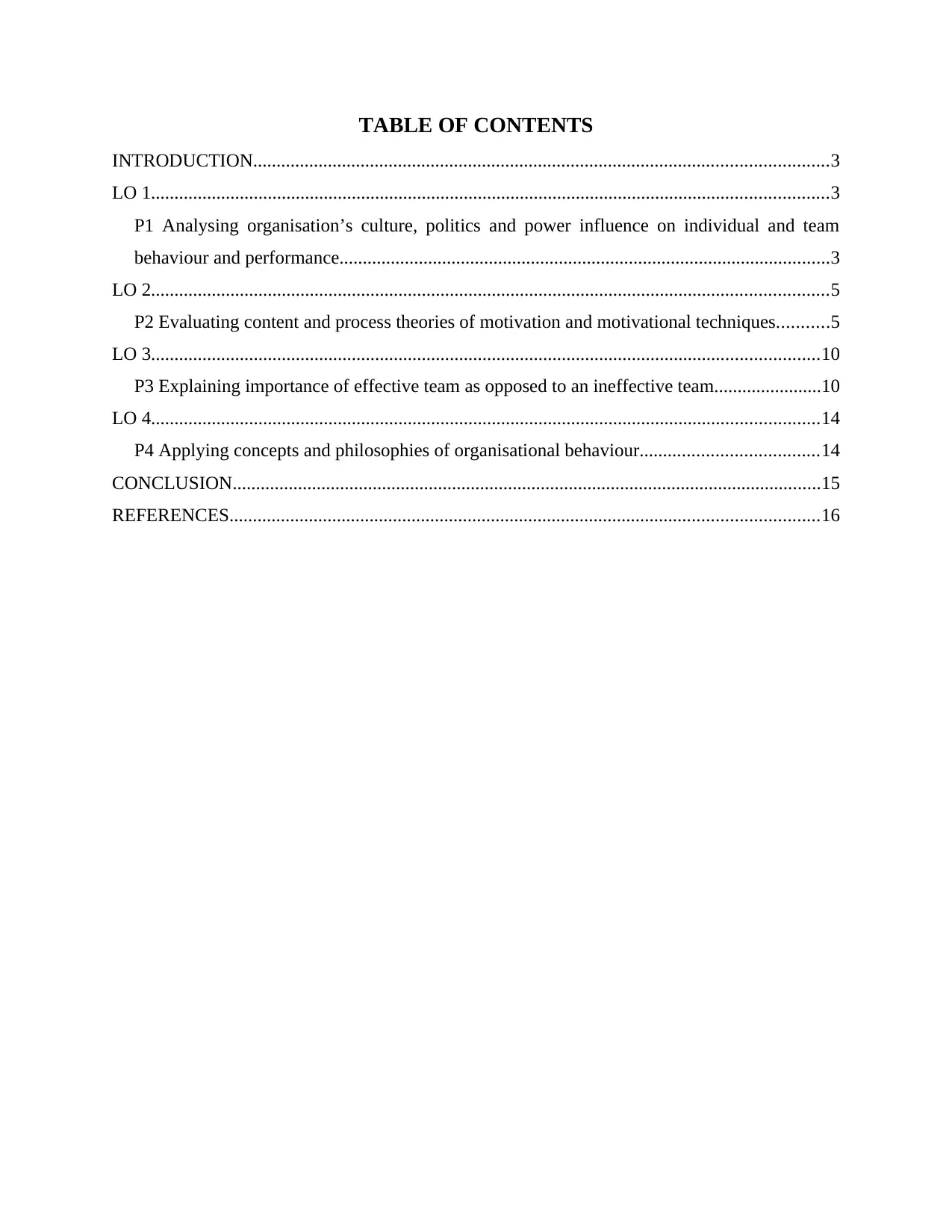
TABLE OF CONTENTS
INTRODUCTION...........................................................................................................................3
LO 1.................................................................................................................................................3
P1 Analysing organisation’s culture, politics and power influence on individual and team
behaviour and performance.........................................................................................................3
LO 2.................................................................................................................................................5
P2 Evaluating content and process theories of motivation and motivational techniques...........5
LO 3...............................................................................................................................................10
P3 Explaining importance of effective team as opposed to an ineffective team.......................10
LO 4...............................................................................................................................................14
P4 Applying concepts and philosophies of organisational behaviour......................................14
CONCLUSION..............................................................................................................................15
REFERENCES..............................................................................................................................16
INTRODUCTION...........................................................................................................................3
LO 1.................................................................................................................................................3
P1 Analysing organisation’s culture, politics and power influence on individual and team
behaviour and performance.........................................................................................................3
LO 2.................................................................................................................................................5
P2 Evaluating content and process theories of motivation and motivational techniques...........5
LO 3...............................................................................................................................................10
P3 Explaining importance of effective team as opposed to an ineffective team.......................10
LO 4...............................................................................................................................................14
P4 Applying concepts and philosophies of organisational behaviour......................................14
CONCLUSION..............................................................................................................................15
REFERENCES..............................................................................................................................16
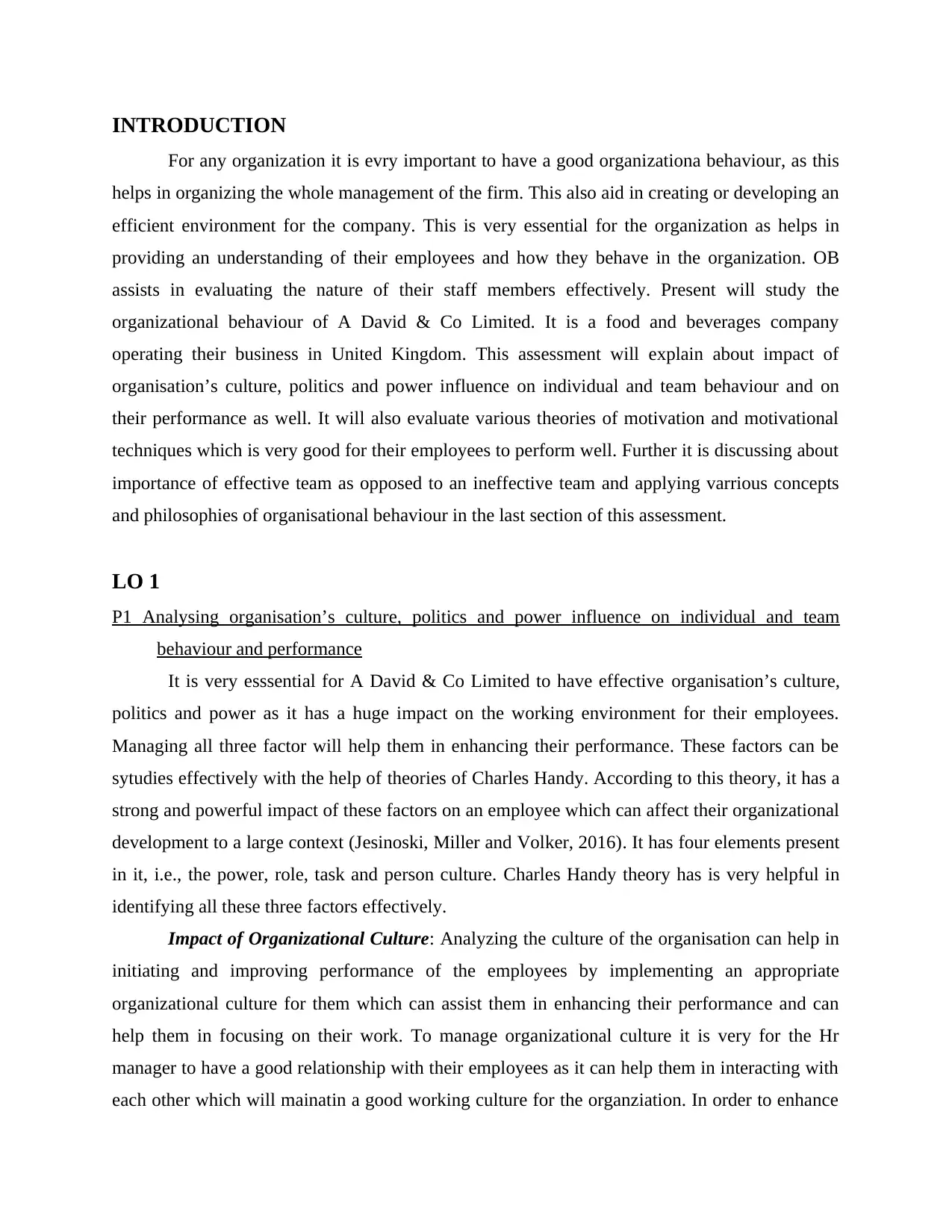
INTRODUCTION
For any organization it is evry important to have a good organizationa behaviour, as this
helps in organizing the whole management of the firm. This also aid in creating or developing an
efficient environment for the company. This is very essential for the organization as helps in
providing an understanding of their employees and how they behave in the organization. OB
assists in evaluating the nature of their staff members effectively. Present will study the
organizational behaviour of A David & Co Limited. It is a food and beverages company
operating their business in United Kingdom. This assessment will explain about impact of
organisation’s culture, politics and power influence on individual and team behaviour and on
their performance as well. It will also evaluate various theories of motivation and motivational
techniques which is very good for their employees to perform well. Further it is discussing about
importance of effective team as opposed to an ineffective team and applying varrious concepts
and philosophies of organisational behaviour in the last section of this assessment.
LO 1
P1 Analysing organisation’s culture, politics and power influence on individual and team
behaviour and performance
It is very esssential for A David & Co Limited to have effective organisation’s culture,
politics and power as it has a huge impact on the working environment for their employees.
Managing all three factor will help them in enhancing their performance. These factors can be
sytudies effectively with the help of theories of Charles Handy. According to this theory, it has a
strong and powerful impact of these factors on an employee which can affect their organizational
development to a large context (Jesinoski, Miller and Volker, 2016). It has four elements present
in it, i.e., the power, role, task and person culture. Charles Handy theory has is very helpful in
identifying all these three factors effectively.
Impact of Organizational Culture: Analyzing the culture of the organisation can help in
initiating and improving performance of the employees by implementing an appropriate
organizational culture for them which can assist them in enhancing their performance and can
help them in focusing on their work. To manage organizational culture it is very for the Hr
manager to have a good relationship with their employees as it can help them in interacting with
each other which will mainatin a good working culture for the organziation. In order to enhance
For any organization it is evry important to have a good organizationa behaviour, as this
helps in organizing the whole management of the firm. This also aid in creating or developing an
efficient environment for the company. This is very essential for the organization as helps in
providing an understanding of their employees and how they behave in the organization. OB
assists in evaluating the nature of their staff members effectively. Present will study the
organizational behaviour of A David & Co Limited. It is a food and beverages company
operating their business in United Kingdom. This assessment will explain about impact of
organisation’s culture, politics and power influence on individual and team behaviour and on
their performance as well. It will also evaluate various theories of motivation and motivational
techniques which is very good for their employees to perform well. Further it is discussing about
importance of effective team as opposed to an ineffective team and applying varrious concepts
and philosophies of organisational behaviour in the last section of this assessment.
LO 1
P1 Analysing organisation’s culture, politics and power influence on individual and team
behaviour and performance
It is very esssential for A David & Co Limited to have effective organisation’s culture,
politics and power as it has a huge impact on the working environment for their employees.
Managing all three factor will help them in enhancing their performance. These factors can be
sytudies effectively with the help of theories of Charles Handy. According to this theory, it has a
strong and powerful impact of these factors on an employee which can affect their organizational
development to a large context (Jesinoski, Miller and Volker, 2016). It has four elements present
in it, i.e., the power, role, task and person culture. Charles Handy theory has is very helpful in
identifying all these three factors effectively.
Impact of Organizational Culture: Analyzing the culture of the organisation can help in
initiating and improving performance of the employees by implementing an appropriate
organizational culture for them which can assist them in enhancing their performance and can
help them in focusing on their work. To manage organizational culture it is very for the Hr
manager to have a good relationship with their employees as it can help them in interacting with
each other which will mainatin a good working culture for the organziation. In order to enhance
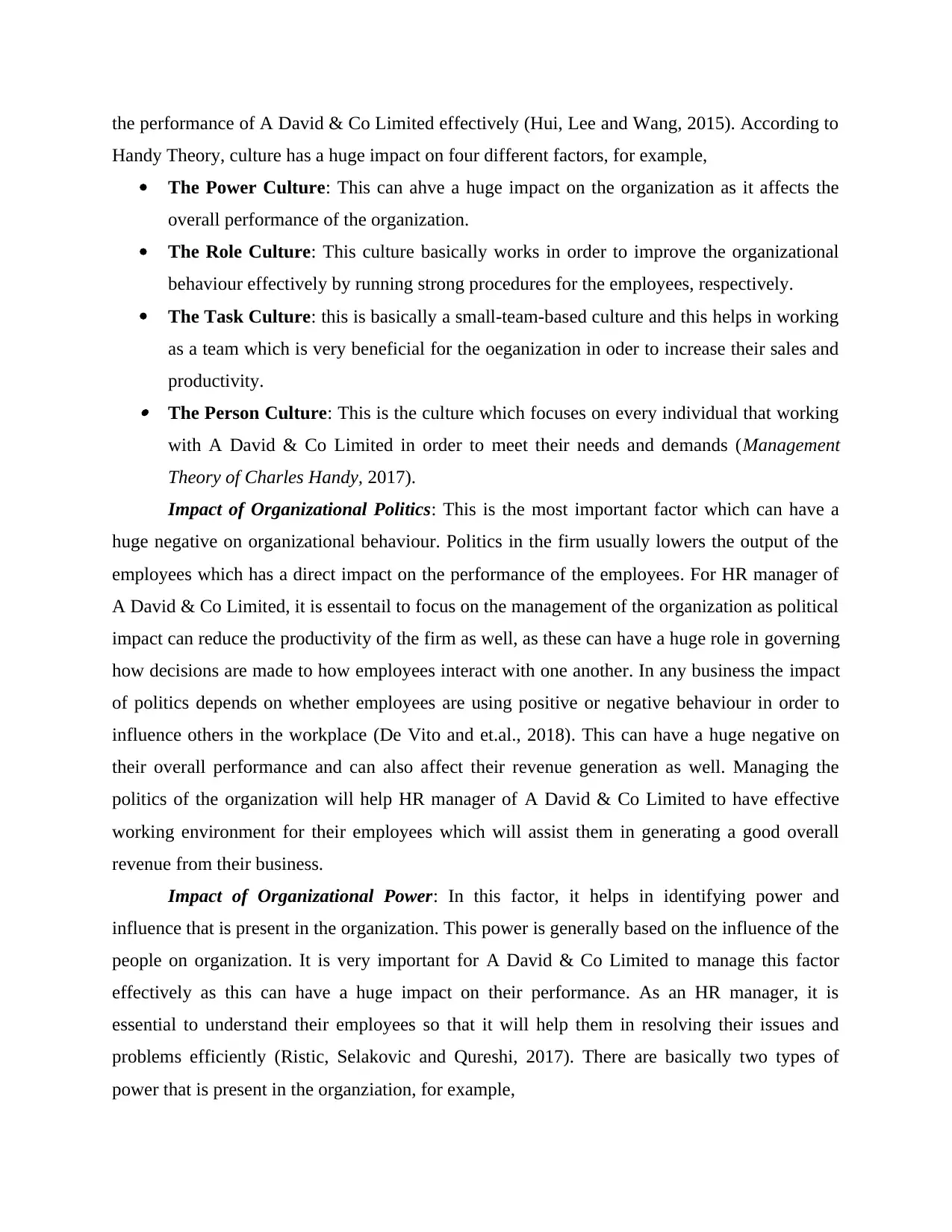
the performance of A David & Co Limited effectively (Hui, Lee and Wang, 2015). According to
Handy Theory, culture has a huge impact on four different factors, for example,
The Power Culture: This can ahve a huge impact on the organization as it affects the
overall performance of the organization.
The Role Culture: This culture basically works in order to improve the organizational
behaviour effectively by running strong procedures for the employees, respectively.
The Task Culture: this is basically a small-team-based culture and this helps in working
as a team which is very beneficial for the oeganization in oder to increase their sales and
productivity. The Person Culture: This is the culture which focuses on every individual that working
with A David & Co Limited in order to meet their needs and demands (Management
Theory of Charles Handy, 2017).
Impact of Organizational Politics: This is the most important factor which can have a
huge negative on organizational behaviour. Politics in the firm usually lowers the output of the
employees which has a direct impact on the performance of the employees. For HR manager of
A David & Co Limited, it is essentail to focus on the management of the organization as political
impact can reduce the productivity of the firm as well, as these can have a huge role in governing
how decisions are made to how employees interact with one another. In any business the impact
of politics depends on whether employees are using positive or negative behaviour in order to
influence others in the workplace (De Vito and et.al., 2018). This can have a huge negative on
their overall performance and can also affect their revenue generation as well. Managing the
politics of the organization will help HR manager of A David & Co Limited to have effective
working environment for their employees which will assist them in generating a good overall
revenue from their business.
Impact of Organizational Power: In this factor, it helps in identifying power and
influence that is present in the organization. This power is generally based on the influence of the
people on organization. It is very important for A David & Co Limited to manage this factor
effectively as this can have a huge impact on their performance. As an HR manager, it is
essential to understand their employees so that it will help them in resolving their issues and
problems efficiently (Ristic, Selakovic and Qureshi, 2017). There are basically two types of
power that is present in the organziation, for example,
Handy Theory, culture has a huge impact on four different factors, for example,
The Power Culture: This can ahve a huge impact on the organization as it affects the
overall performance of the organization.
The Role Culture: This culture basically works in order to improve the organizational
behaviour effectively by running strong procedures for the employees, respectively.
The Task Culture: this is basically a small-team-based culture and this helps in working
as a team which is very beneficial for the oeganization in oder to increase their sales and
productivity. The Person Culture: This is the culture which focuses on every individual that working
with A David & Co Limited in order to meet their needs and demands (Management
Theory of Charles Handy, 2017).
Impact of Organizational Politics: This is the most important factor which can have a
huge negative on organizational behaviour. Politics in the firm usually lowers the output of the
employees which has a direct impact on the performance of the employees. For HR manager of
A David & Co Limited, it is essentail to focus on the management of the organization as political
impact can reduce the productivity of the firm as well, as these can have a huge role in governing
how decisions are made to how employees interact with one another. In any business the impact
of politics depends on whether employees are using positive or negative behaviour in order to
influence others in the workplace (De Vito and et.al., 2018). This can have a huge negative on
their overall performance and can also affect their revenue generation as well. Managing the
politics of the organization will help HR manager of A David & Co Limited to have effective
working environment for their employees which will assist them in generating a good overall
revenue from their business.
Impact of Organizational Power: In this factor, it helps in identifying power and
influence that is present in the organization. This power is generally based on the influence of the
people on organization. It is very important for A David & Co Limited to manage this factor
effectively as this can have a huge impact on their performance. As an HR manager, it is
essential to understand their employees so that it will help them in resolving their issues and
problems efficiently (Ristic, Selakovic and Qureshi, 2017). There are basically two types of
power that is present in the organziation, for example,
Secure Best Marks with AI Grader
Need help grading? Try our AI Grader for instant feedback on your assignments.
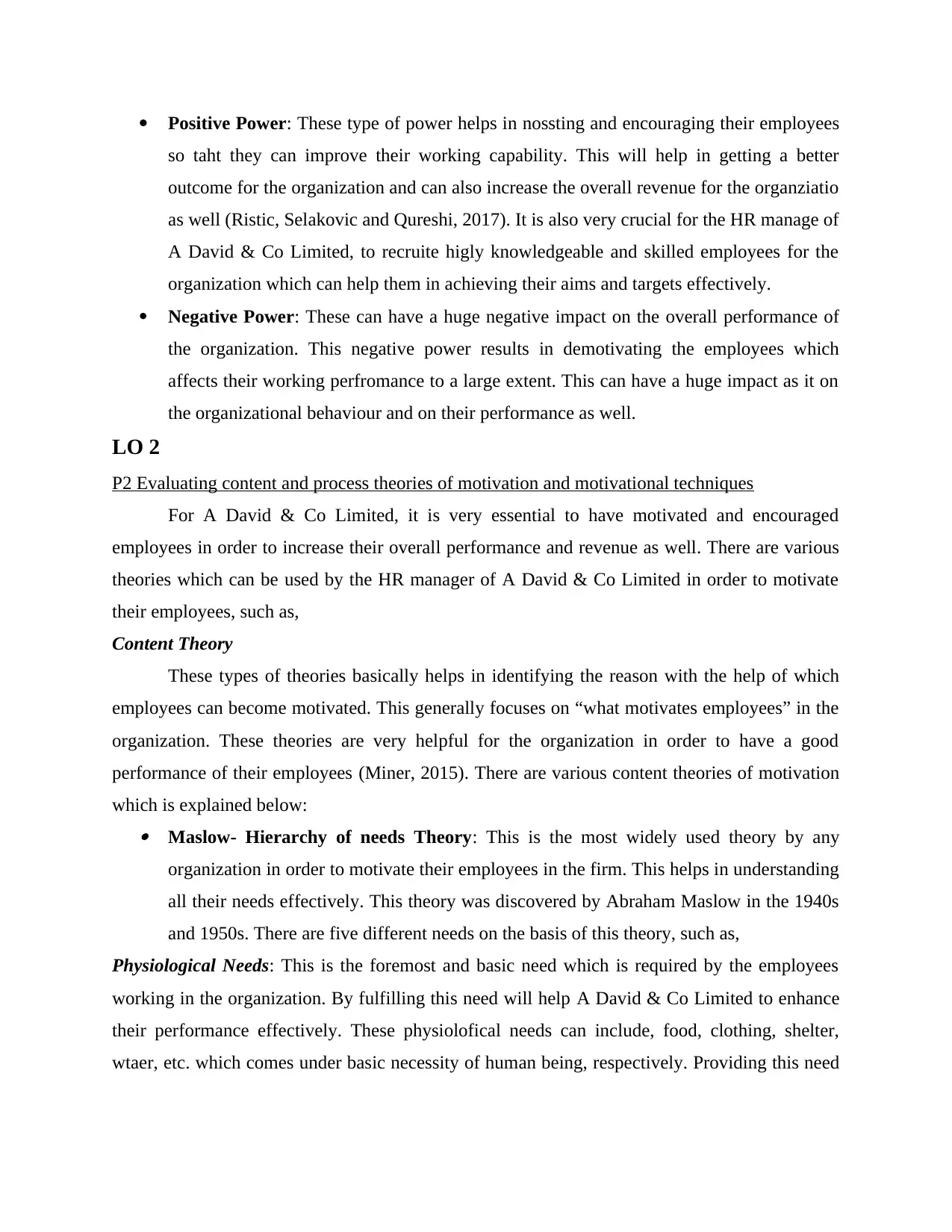
Positive Power: These type of power helps in nossting and encouraging their employees
so taht they can improve their working capability. This will help in getting a better
outcome for the organization and can also increase the overall revenue for the organziatio
as well (Ristic, Selakovic and Qureshi, 2017). It is also very crucial for the HR manage of
A David & Co Limited, to recruite higly knowledgeable and skilled employees for the
organization which can help them in achieving their aims and targets effectively.
Negative Power: These can have a huge negative impact on the overall performance of
the organization. This negative power results in demotivating the employees which
affects their working perfromance to a large extent. This can have a huge impact as it on
the organizational behaviour and on their performance as well.
LO 2
P2 Evaluating content and process theories of motivation and motivational techniques
For A David & Co Limited, it is very essential to have motivated and encouraged
employees in order to increase their overall performance and revenue as well. There are various
theories which can be used by the HR manager of A David & Co Limited in order to motivate
their employees, such as,
Content Theory
These types of theories basically helps in identifying the reason with the help of which
employees can become motivated. This generally focuses on “what motivates employees” in the
organization. These theories are very helpful for the organization in order to have a good
performance of their employees (Miner, 2015). There are various content theories of motivation
which is explained below: Maslow- Hierarchy of needs Theory: This is the most widely used theory by any
organization in order to motivate their employees in the firm. This helps in understanding
all their needs effectively. This theory was discovered by Abraham Maslow in the 1940s
and 1950s. There are five different needs on the basis of this theory, such as,
Physiological Needs: This is the foremost and basic need which is required by the employees
working in the organization. By fulfilling this need will help A David & Co Limited to enhance
their performance effectively. These physiolofical needs can include, food, clothing, shelter,
wtaer, etc. which comes under basic necessity of human being, respectively. Providing this need
so taht they can improve their working capability. This will help in getting a better
outcome for the organization and can also increase the overall revenue for the organziatio
as well (Ristic, Selakovic and Qureshi, 2017). It is also very crucial for the HR manage of
A David & Co Limited, to recruite higly knowledgeable and skilled employees for the
organization which can help them in achieving their aims and targets effectively.
Negative Power: These can have a huge negative impact on the overall performance of
the organization. This negative power results in demotivating the employees which
affects their working perfromance to a large extent. This can have a huge impact as it on
the organizational behaviour and on their performance as well.
LO 2
P2 Evaluating content and process theories of motivation and motivational techniques
For A David & Co Limited, it is very essential to have motivated and encouraged
employees in order to increase their overall performance and revenue as well. There are various
theories which can be used by the HR manager of A David & Co Limited in order to motivate
their employees, such as,
Content Theory
These types of theories basically helps in identifying the reason with the help of which
employees can become motivated. This generally focuses on “what motivates employees” in the
organization. These theories are very helpful for the organization in order to have a good
performance of their employees (Miner, 2015). There are various content theories of motivation
which is explained below: Maslow- Hierarchy of needs Theory: This is the most widely used theory by any
organization in order to motivate their employees in the firm. This helps in understanding
all their needs effectively. This theory was discovered by Abraham Maslow in the 1940s
and 1950s. There are five different needs on the basis of this theory, such as,
Physiological Needs: This is the foremost and basic need which is required by the employees
working in the organization. By fulfilling this need will help A David & Co Limited to enhance
their performance effectively. These physiolofical needs can include, food, clothing, shelter,
wtaer, etc. which comes under basic necessity of human being, respectively. Providing this need
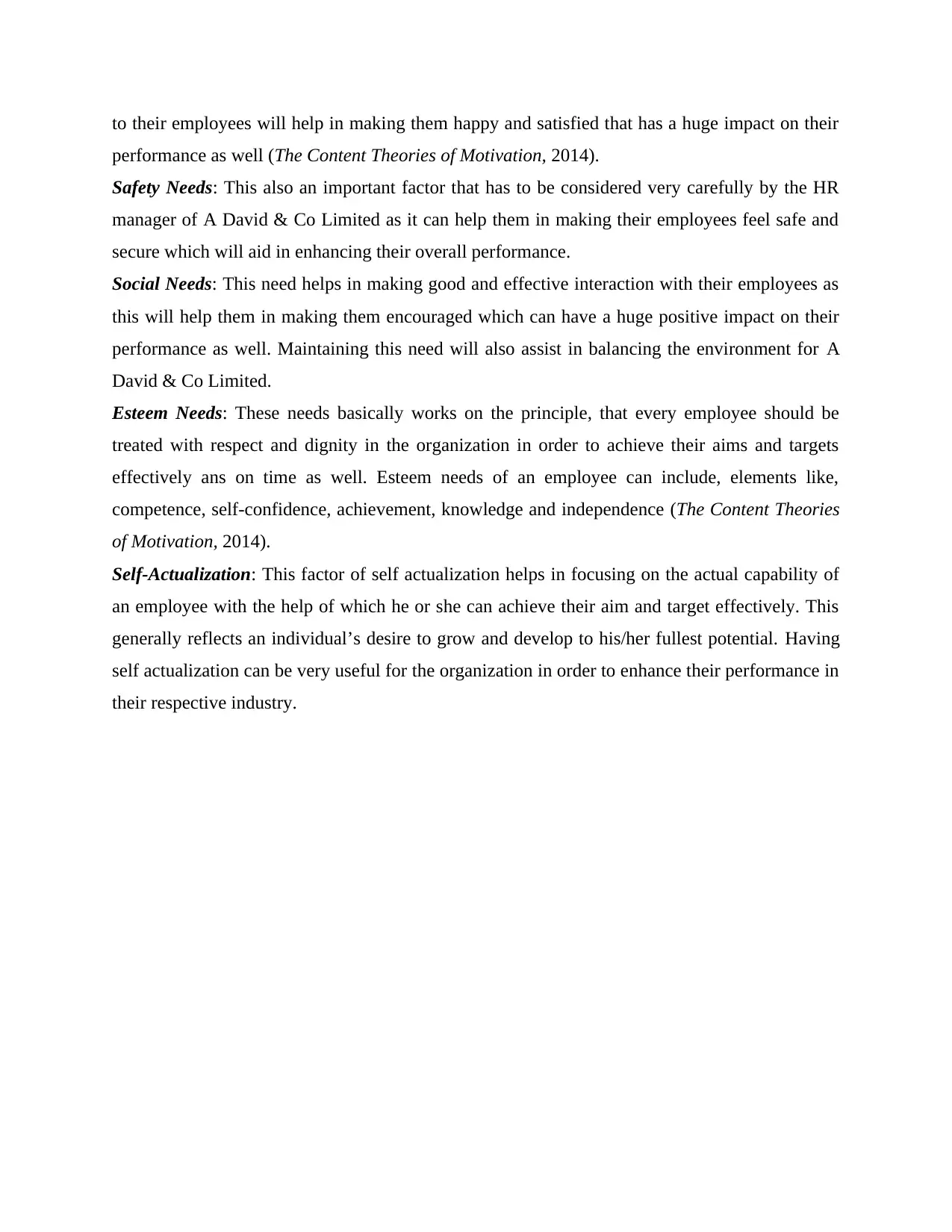
to their employees will help in making them happy and satisfied that has a huge impact on their
performance as well (The Content Theories of Motivation, 2014).
Safety Needs: This also an important factor that has to be considered very carefully by the HR
manager of A David & Co Limited as it can help them in making their employees feel safe and
secure which will aid in enhancing their overall performance.
Social Needs: This need helps in making good and effective interaction with their employees as
this will help them in making them encouraged which can have a huge positive impact on their
performance as well. Maintaining this need will also assist in balancing the environment for A
David & Co Limited.
Esteem Needs: These needs basically works on the principle, that every employee should be
treated with respect and dignity in the organization in order to achieve their aims and targets
effectively ans on time as well. Esteem needs of an employee can include, elements like,
competence, self-confidence, achievement, knowledge and independence (The Content Theories
of Motivation, 2014).
Self-Actualization: This factor of self actualization helps in focusing on the actual capability of
an employee with the help of which he or she can achieve their aim and target effectively. This
generally reflects an individual’s desire to grow and develop to his/her fullest potential. Having
self actualization can be very useful for the organization in order to enhance their performance in
their respective industry.
performance as well (The Content Theories of Motivation, 2014).
Safety Needs: This also an important factor that has to be considered very carefully by the HR
manager of A David & Co Limited as it can help them in making their employees feel safe and
secure which will aid in enhancing their overall performance.
Social Needs: This need helps in making good and effective interaction with their employees as
this will help them in making them encouraged which can have a huge positive impact on their
performance as well. Maintaining this need will also assist in balancing the environment for A
David & Co Limited.
Esteem Needs: These needs basically works on the principle, that every employee should be
treated with respect and dignity in the organization in order to achieve their aims and targets
effectively ans on time as well. Esteem needs of an employee can include, elements like,
competence, self-confidence, achievement, knowledge and independence (The Content Theories
of Motivation, 2014).
Self-Actualization: This factor of self actualization helps in focusing on the actual capability of
an employee with the help of which he or she can achieve their aim and target effectively. This
generally reflects an individual’s desire to grow and develop to his/her fullest potential. Having
self actualization can be very useful for the organization in order to enhance their performance in
their respective industry.

Herzberg- Two factor Theory: This theory was discovered by psychologist Frederick
Herzberg in the 1950s. This is also known as Herzberg’s Motivation Hygiene theory.
Herzberg’s has found two factors which can have a huge impact on the employees and
can also affect their performance as well. These two factors are explained below:
Motivator Factors: This factors helps in keeping the employees of A David & Co Limited
motivated in order to enhance their performance. These motivator factors can include, their
employee's individual need which can help in increasing job satisfaction as well (Chen and et.al.,
2017).
Hygiene Factors: This factors is very important for an organization to maintain their
organizational behaviour effectively. These factors can include, income, working place and
environment, safety and security at work place, etc.
These two factors have to be considered very carefully in order to reduce the chances of
dissatisfaction of their employees.
Illustration 1: Maslow- Hierarchy of needs Theory
Source: (Content Theory, 2014)
Herzberg in the 1950s. This is also known as Herzberg’s Motivation Hygiene theory.
Herzberg’s has found two factors which can have a huge impact on the employees and
can also affect their performance as well. These two factors are explained below:
Motivator Factors: This factors helps in keeping the employees of A David & Co Limited
motivated in order to enhance their performance. These motivator factors can include, their
employee's individual need which can help in increasing job satisfaction as well (Chen and et.al.,
2017).
Hygiene Factors: This factors is very important for an organization to maintain their
organizational behaviour effectively. These factors can include, income, working place and
environment, safety and security at work place, etc.
These two factors have to be considered very carefully in order to reduce the chances of
dissatisfaction of their employees.
Illustration 1: Maslow- Hierarchy of needs Theory
Source: (Content Theory, 2014)
Paraphrase This Document
Need a fresh take? Get an instant paraphrase of this document with our AI Paraphraser

Process Theory
This process theory helps in generating ideas which can be very helpful for the
organization in order to enhance the performance in the industry. This theory explains the factors
with the help of which motivation can be induced in the employees. It is very important for the
HR manager of A David and Co Limited to carefully implement this theory in the firm in order
to get better results (Van Knippenberg and Hogg, 2018). There are various theories which is
included in this theory, such as,
Vroom's Expectancy Theory: The main aim of this theory is to focus on the content and
process of all the motivational factors which can help them in enhancing the performance
of the organization. This Vroom's theory also helps in encouraging their employees by
keeping them motivated and boosted. This theory has three elements that is present in it,
such as,
Illust
ration 2: Herzberg’s Two Factor Theory
(Source: Motivation Theories, 2017)
This process theory helps in generating ideas which can be very helpful for the
organization in order to enhance the performance in the industry. This theory explains the factors
with the help of which motivation can be induced in the employees. It is very important for the
HR manager of A David and Co Limited to carefully implement this theory in the firm in order
to get better results (Van Knippenberg and Hogg, 2018). There are various theories which is
included in this theory, such as,
Vroom's Expectancy Theory: The main aim of this theory is to focus on the content and
process of all the motivational factors which can help them in enhancing the performance
of the organization. This Vroom's theory also helps in encouraging their employees by
keeping them motivated and boosted. This theory has three elements that is present in it,
such as,
Illust
ration 2: Herzberg’s Two Factor Theory
(Source: Motivation Theories, 2017)
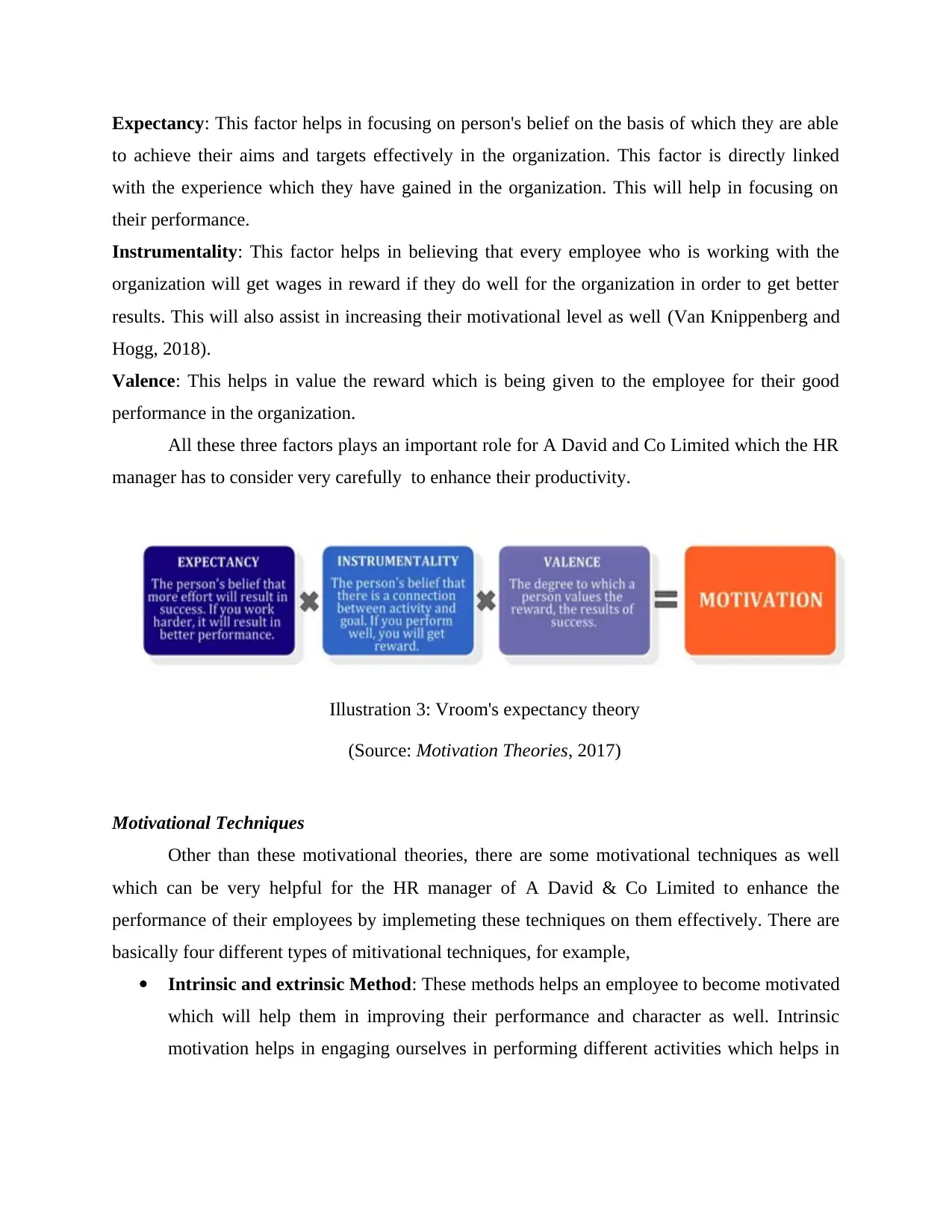
Expectancy: This factor helps in focusing on person's belief on the basis of which they are able
to achieve their aims and targets effectively in the organization. This factor is directly linked
with the experience which they have gained in the organization. This will help in focusing on
their performance.
Instrumentality: This factor helps in believing that every employee who is working with the
organization will get wages in reward if they do well for the organization in order to get better
results. This will also assist in increasing their motivational level as well (Van Knippenberg and
Hogg, 2018).
Valence: This helps in value the reward which is being given to the employee for their good
performance in the organization.
All these three factors plays an important role for A David and Co Limited which the HR
manager has to consider very carefully to enhance their productivity.
Motivational Techniques
Other than these motivational theories, there are some motivational techniques as well
which can be very helpful for the HR manager of A David & Co Limited to enhance the
performance of their employees by implemeting these techniques on them effectively. There are
basically four different types of mitivational techniques, for example,
Intrinsic and extrinsic Method: These methods helps an employee to become motivated
which will help them in improving their performance and character as well. Intrinsic
motivation helps in engaging ourselves in performing different activities which helps in
Illustration 3: Vroom's expectancy theory
(Source: Motivation Theories, 2017)
to achieve their aims and targets effectively in the organization. This factor is directly linked
with the experience which they have gained in the organization. This will help in focusing on
their performance.
Instrumentality: This factor helps in believing that every employee who is working with the
organization will get wages in reward if they do well for the organization in order to get better
results. This will also assist in increasing their motivational level as well (Van Knippenberg and
Hogg, 2018).
Valence: This helps in value the reward which is being given to the employee for their good
performance in the organization.
All these three factors plays an important role for A David and Co Limited which the HR
manager has to consider very carefully to enhance their productivity.
Motivational Techniques
Other than these motivational theories, there are some motivational techniques as well
which can be very helpful for the HR manager of A David & Co Limited to enhance the
performance of their employees by implemeting these techniques on them effectively. There are
basically four different types of mitivational techniques, for example,
Intrinsic and extrinsic Method: These methods helps an employee to become motivated
which will help them in improving their performance and character as well. Intrinsic
motivation helps in engaging ourselves in performing different activities which helps in
Illustration 3: Vroom's expectancy theory
(Source: Motivation Theories, 2017)
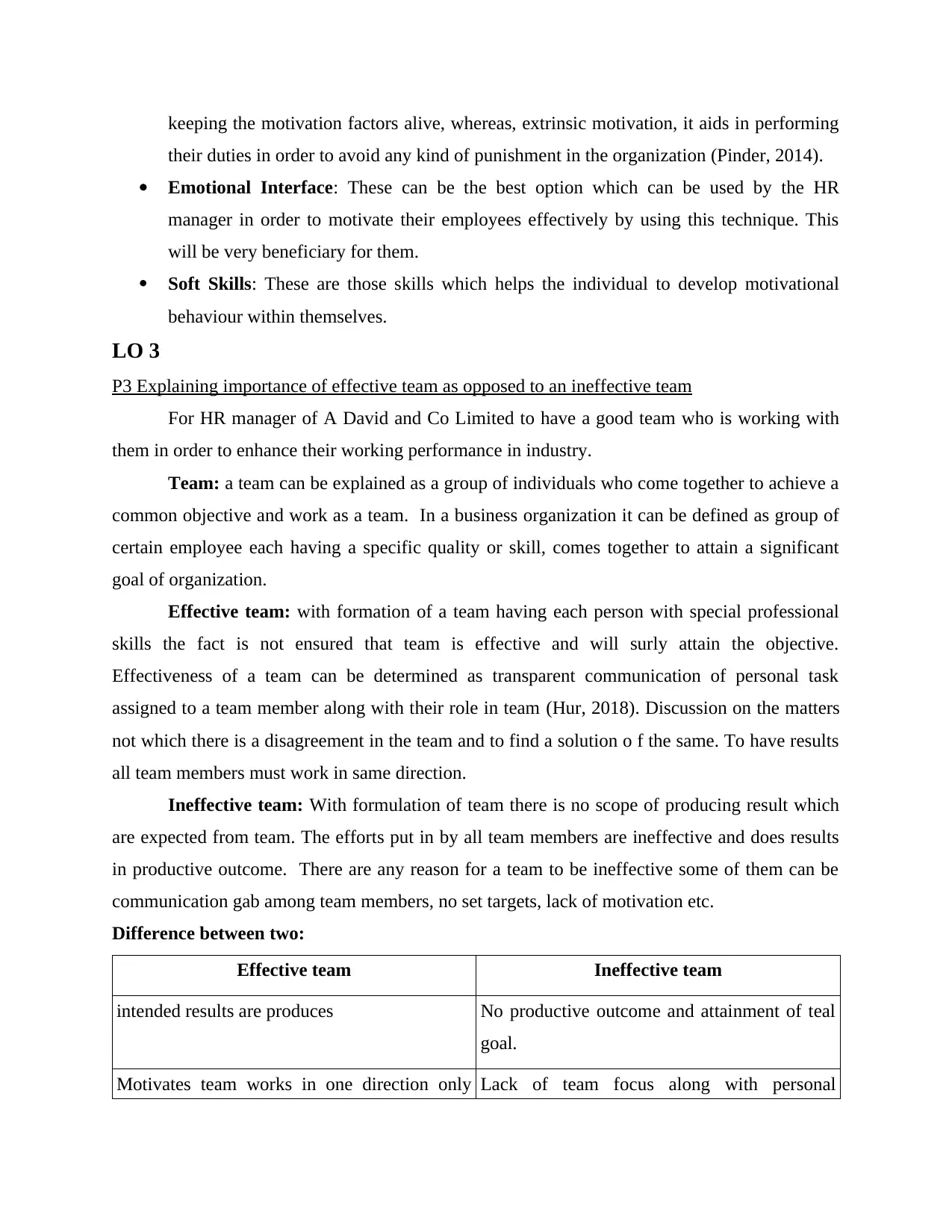
keeping the motivation factors alive, whereas, extrinsic motivation, it aids in performing
their duties in order to avoid any kind of punishment in the organization (Pinder, 2014).
Emotional Interface: These can be the best option which can be used by the HR
manager in order to motivate their employees effectively by using this technique. This
will be very beneficiary for them.
Soft Skills: These are those skills which helps the individual to develop motivational
behaviour within themselves.
LO 3
P3 Explaining importance of effective team as opposed to an ineffective team
For HR manager of A David and Co Limited to have a good team who is working with
them in order to enhance their working performance in industry.
Team: a team can be explained as a group of individuals who come together to achieve a
common objective and work as a team. In a business organization it can be defined as group of
certain employee each having a specific quality or skill, comes together to attain a significant
goal of organization.
Effective team: with formation of a team having each person with special professional
skills the fact is not ensured that team is effective and will surly attain the objective.
Effectiveness of a team can be determined as transparent communication of personal task
assigned to a team member along with their role in team (Hur, 2018). Discussion on the matters
not which there is a disagreement in the team and to find a solution o f the same. To have results
all team members must work in same direction.
Ineffective team: With formulation of team there is no scope of producing result which
are expected from team. The efforts put in by all team members are ineffective and does results
in productive outcome. There are any reason for a team to be ineffective some of them can be
communication gab among team members, no set targets, lack of motivation etc.
Difference between two:
Effective team Ineffective team
intended results are produces No productive outcome and attainment of teal
goal.
Motivates team works in one direction only Lack of team focus along with personal
their duties in order to avoid any kind of punishment in the organization (Pinder, 2014).
Emotional Interface: These can be the best option which can be used by the HR
manager in order to motivate their employees effectively by using this technique. This
will be very beneficiary for them.
Soft Skills: These are those skills which helps the individual to develop motivational
behaviour within themselves.
LO 3
P3 Explaining importance of effective team as opposed to an ineffective team
For HR manager of A David and Co Limited to have a good team who is working with
them in order to enhance their working performance in industry.
Team: a team can be explained as a group of individuals who come together to achieve a
common objective and work as a team. In a business organization it can be defined as group of
certain employee each having a specific quality or skill, comes together to attain a significant
goal of organization.
Effective team: with formation of a team having each person with special professional
skills the fact is not ensured that team is effective and will surly attain the objective.
Effectiveness of a team can be determined as transparent communication of personal task
assigned to a team member along with their role in team (Hur, 2018). Discussion on the matters
not which there is a disagreement in the team and to find a solution o f the same. To have results
all team members must work in same direction.
Ineffective team: With formulation of team there is no scope of producing result which
are expected from team. The efforts put in by all team members are ineffective and does results
in productive outcome. There are any reason for a team to be ineffective some of them can be
communication gab among team members, no set targets, lack of motivation etc.
Difference between two:
Effective team Ineffective team
intended results are produces No productive outcome and attainment of teal
goal.
Motivates team works in one direction only Lack of team focus along with personal
Secure Best Marks with AI Grader
Need help grading? Try our AI Grader for instant feedback on your assignments.
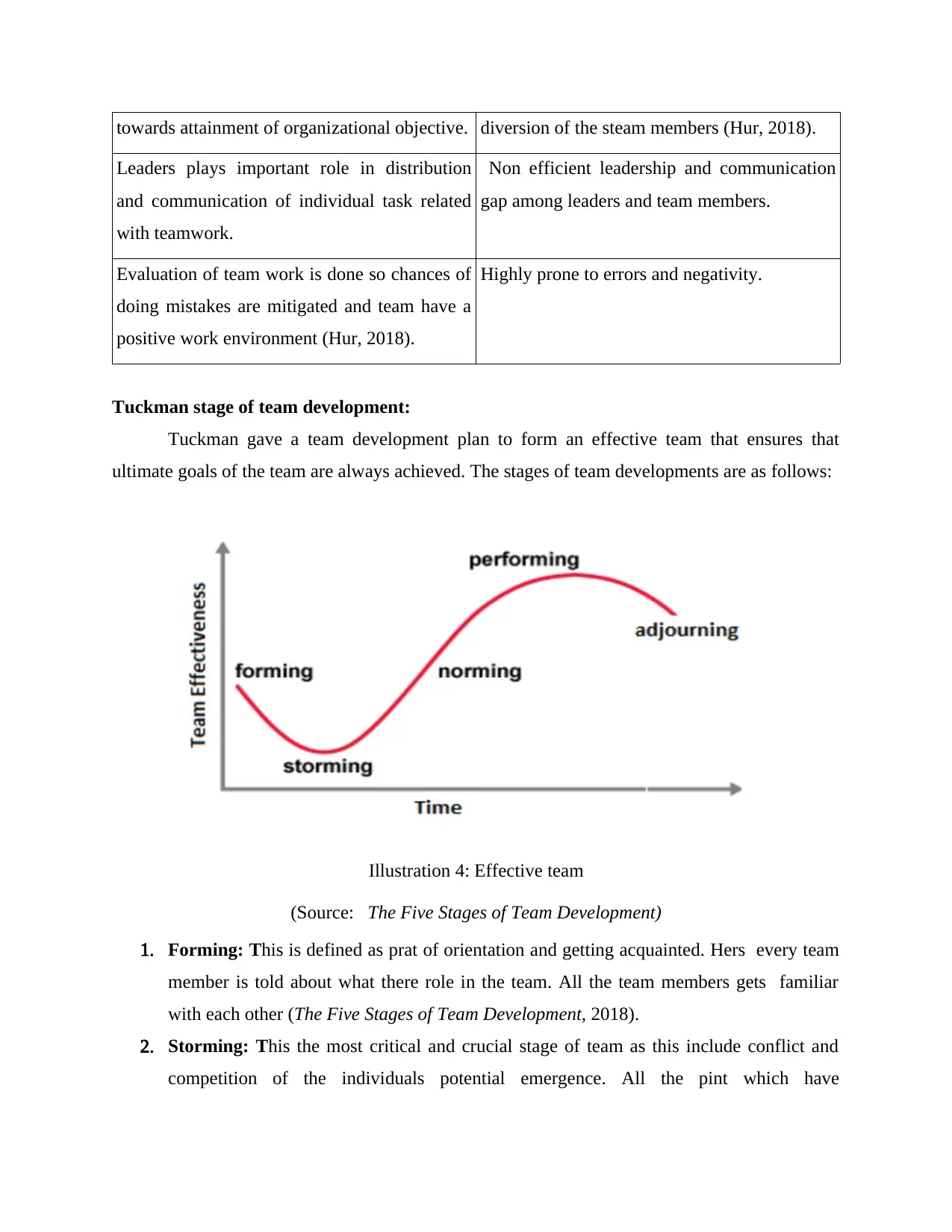
towards attainment of organizational objective. diversion of the steam members (Hur, 2018).
Leaders plays important role in distribution
and communication of individual task related
with teamwork.
Non efficient leadership and communication
gap among leaders and team members.
Evaluation of team work is done so chances of
doing mistakes are mitigated and team have a
positive work environment (Hur, 2018).
Highly prone to errors and negativity.
Tuckman stage of team development:
Tuckman gave a team development plan to form an effective team that ensures that
ultimate goals of the team are always achieved. The stages of team developments are as follows:
Illustration 4: Effective team
(Source: The Five Stages of Team Development)
1. Forming: This is defined as prat of orientation and getting acquainted. Hers every team
member is told about what there role in the team. All the team members gets familiar
with each other (The Five Stages of Team Development, 2018).
2. Storming: This the most critical and crucial stage of team as this include conflict and
competition of the individuals potential emergence. All the pint which have
Leaders plays important role in distribution
and communication of individual task related
with teamwork.
Non efficient leadership and communication
gap among leaders and team members.
Evaluation of team work is done so chances of
doing mistakes are mitigated and team have a
positive work environment (Hur, 2018).
Highly prone to errors and negativity.
Tuckman stage of team development:
Tuckman gave a team development plan to form an effective team that ensures that
ultimate goals of the team are always achieved. The stages of team developments are as follows:
Illustration 4: Effective team
(Source: The Five Stages of Team Development)
1. Forming: This is defined as prat of orientation and getting acquainted. Hers every team
member is told about what there role in the team. All the team members gets familiar
with each other (The Five Stages of Team Development, 2018).
2. Storming: This the most critical and crucial stage of team as this include conflict and
competition of the individuals potential emergence. All the pint which have
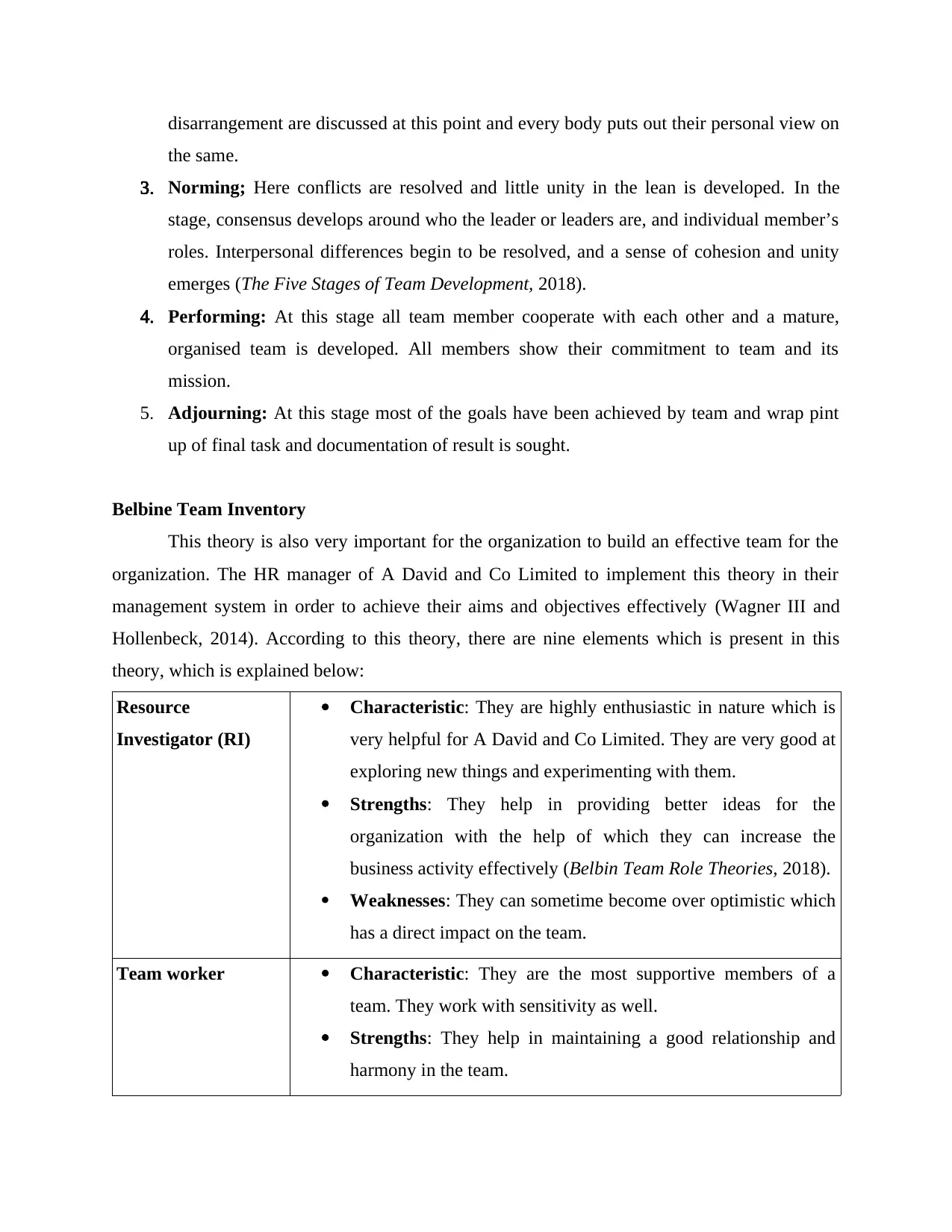
disarrangement are discussed at this point and every body puts out their personal view on
the same.
3. Norming; Here conflicts are resolved and little unity in the lean is developed. In the
stage, consensus develops around who the leader or leaders are, and individual member’s
roles. Interpersonal differences begin to be resolved, and a sense of cohesion and unity
emerges (The Five Stages of Team Development, 2018).
4. Performing: At this stage all team member cooperate with each other and a mature,
organised team is developed. All members show their commitment to team and its
mission.
5. Adjourning: At this stage most of the goals have been achieved by team and wrap pint
up of final task and documentation of result is sought.
Belbine Team Inventory
This theory is also very important for the organization to build an effective team for the
organization. The HR manager of A David and Co Limited to implement this theory in their
management system in order to achieve their aims and objectives effectively (Wagner III and
Hollenbeck, 2014). According to this theory, there are nine elements which is present in this
theory, which is explained below:
Resource
Investigator (RI)
Characteristic: They are highly enthusiastic in nature which is
very helpful for A David and Co Limited. They are very good at
exploring new things and experimenting with them.
Strengths: They help in providing better ideas for the
organization with the help of which they can increase the
business activity effectively (Belbin Team Role Theories, 2018).
Weaknesses: They can sometime become over optimistic which
has a direct impact on the team.
Team worker Characteristic: They are the most supportive members of a
team. They work with sensitivity as well.
Strengths: They help in maintaining a good relationship and
harmony in the team.
the same.
3. Norming; Here conflicts are resolved and little unity in the lean is developed. In the
stage, consensus develops around who the leader or leaders are, and individual member’s
roles. Interpersonal differences begin to be resolved, and a sense of cohesion and unity
emerges (The Five Stages of Team Development, 2018).
4. Performing: At this stage all team member cooperate with each other and a mature,
organised team is developed. All members show their commitment to team and its
mission.
5. Adjourning: At this stage most of the goals have been achieved by team and wrap pint
up of final task and documentation of result is sought.
Belbine Team Inventory
This theory is also very important for the organization to build an effective team for the
organization. The HR manager of A David and Co Limited to implement this theory in their
management system in order to achieve their aims and objectives effectively (Wagner III and
Hollenbeck, 2014). According to this theory, there are nine elements which is present in this
theory, which is explained below:
Resource
Investigator (RI)
Characteristic: They are highly enthusiastic in nature which is
very helpful for A David and Co Limited. They are very good at
exploring new things and experimenting with them.
Strengths: They help in providing better ideas for the
organization with the help of which they can increase the
business activity effectively (Belbin Team Role Theories, 2018).
Weaknesses: They can sometime become over optimistic which
has a direct impact on the team.
Team worker Characteristic: They are the most supportive members of a
team. They work with sensitivity as well.
Strengths: They help in maintaining a good relationship and
harmony in the team.

Weaknesses: They are very complex in nature to understand.
Co-ordinators (CO) Characteristic: They have the ability to work together to
achieve their objectives. They are highly trusted person.
Strengths: They are very good at guiding the team members.
They are also very focused in their work (Wagner III and
Hollenbeck, 2014).
Weaknesses: They can become manipulative in some situations.
Plants (PL) Characteristic: These can be highly innovative and creative in
their work which is very useful for the organization to enhance
their performance. They are independent and clever who can
manage their work effectively. The main function of these is to
generate effective ideas which can be used in resolving complex
issues of the organization (Belbin Team Role Theories, 2018).
Strengths: Helps in producing lots of good ideas for the firm.
Weaknesses: These can be sometimes become over sensitive.
So in order to reduce this they have to be handled very carefully.
Monitor Evaluator
(ME)
Characteristic: They are usually very serious in their work.
They are very slow in making any decisions for the organization.
Strengths: They manage the team very well and ensure that they
reduce the chance of any mistake.
Weaknesses: They can lack in motivating their team sometimes.
They are also very poor in making strong relationships as well.
Specialist Characteristic: They are very dedicated in their work.
Strengths: They have a good command over technical skill.
Weaknesses: They are unable to provide support out of their
specialty zone.
Shaper Characteristic: They are highly motivated people with a lot of
energy.
Strengths: They have very good leadership qualities. Very
Co-ordinators (CO) Characteristic: They have the ability to work together to
achieve their objectives. They are highly trusted person.
Strengths: They are very good at guiding the team members.
They are also very focused in their work (Wagner III and
Hollenbeck, 2014).
Weaknesses: They can become manipulative in some situations.
Plants (PL) Characteristic: These can be highly innovative and creative in
their work which is very useful for the organization to enhance
their performance. They are independent and clever who can
manage their work effectively. The main function of these is to
generate effective ideas which can be used in resolving complex
issues of the organization (Belbin Team Role Theories, 2018).
Strengths: Helps in producing lots of good ideas for the firm.
Weaknesses: These can be sometimes become over sensitive.
So in order to reduce this they have to be handled very carefully.
Monitor Evaluator
(ME)
Characteristic: They are usually very serious in their work.
They are very slow in making any decisions for the organization.
Strengths: They manage the team very well and ensure that they
reduce the chance of any mistake.
Weaknesses: They can lack in motivating their team sometimes.
They are also very poor in making strong relationships as well.
Specialist Characteristic: They are very dedicated in their work.
Strengths: They have a good command over technical skill.
Weaknesses: They are unable to provide support out of their
specialty zone.
Shaper Characteristic: They are highly motivated people with a lot of
energy.
Strengths: They have very good leadership qualities. Very
Paraphrase This Document
Need a fresh take? Get an instant paraphrase of this document with our AI Paraphraser
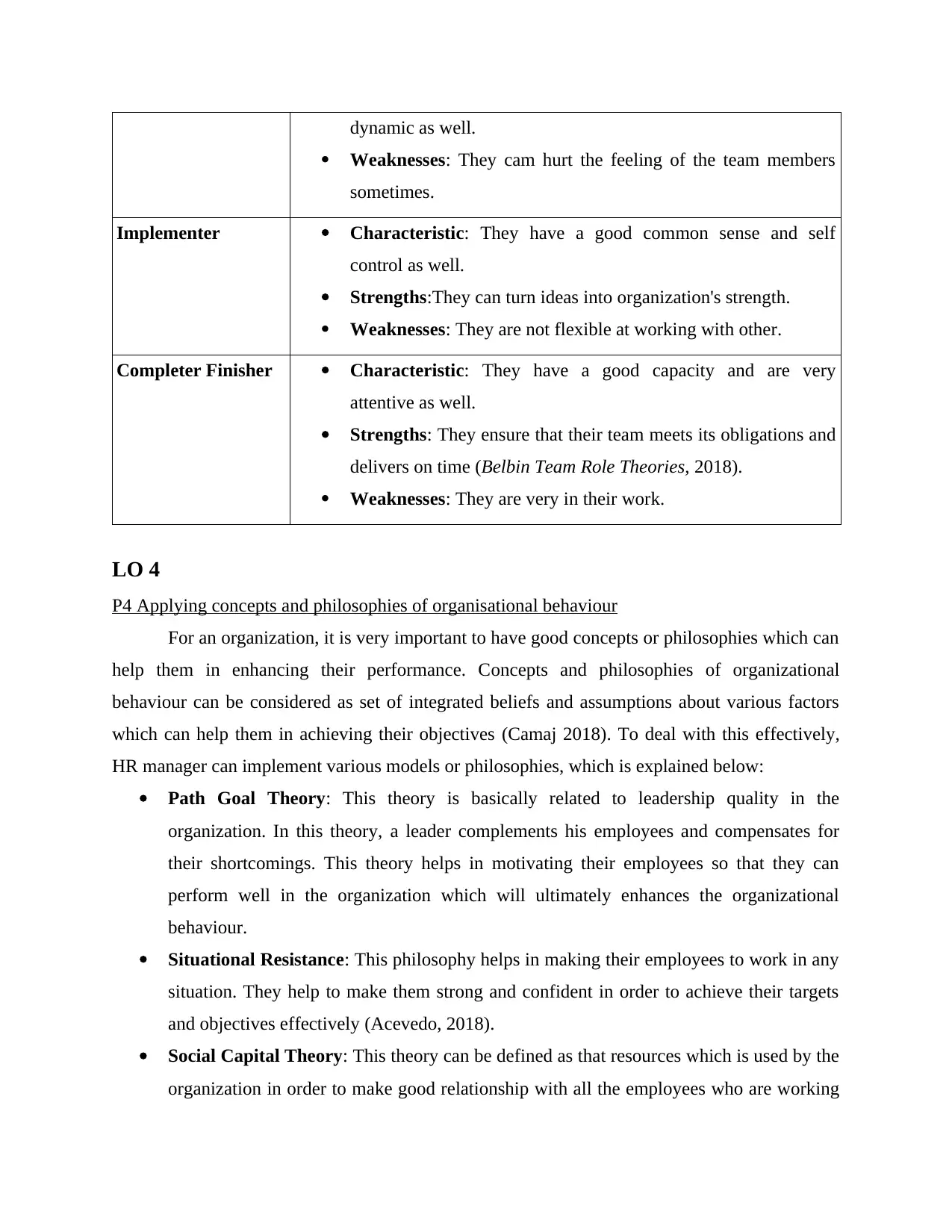
dynamic as well.
Weaknesses: They cam hurt the feeling of the team members
sometimes.
Implementer Characteristic: They have a good common sense and self
control as well.
Strengths:They can turn ideas into organization's strength.
Weaknesses: They are not flexible at working with other.
Completer Finisher Characteristic: They have a good capacity and are very
attentive as well.
Strengths: They ensure that their team meets its obligations and
delivers on time (Belbin Team Role Theories, 2018).
Weaknesses: They are very in their work.
LO 4
P4 Applying concepts and philosophies of organisational behaviour
For an organization, it is very important to have good concepts or philosophies which can
help them in enhancing their performance. Concepts and philosophies of organizational
behaviour can be considered as set of integrated beliefs and assumptions about various factors
which can help them in achieving their objectives (Camaj 2018). To deal with this effectively,
HR manager can implement various models or philosophies, which is explained below:
Path Goal Theory: This theory is basically related to leadership quality in the
organization. In this theory, a leader complements his employees and compensates for
their shortcomings. This theory helps in motivating their employees so that they can
perform well in the organization which will ultimately enhances the organizational
behaviour.
Situational Resistance: This philosophy helps in making their employees to work in any
situation. They help to make them strong and confident in order to achieve their targets
and objectives effectively (Acevedo, 2018).
Social Capital Theory: This theory can be defined as that resources which is used by the
organization in order to make good relationship with all the employees who are working
Weaknesses: They cam hurt the feeling of the team members
sometimes.
Implementer Characteristic: They have a good common sense and self
control as well.
Strengths:They can turn ideas into organization's strength.
Weaknesses: They are not flexible at working with other.
Completer Finisher Characteristic: They have a good capacity and are very
attentive as well.
Strengths: They ensure that their team meets its obligations and
delivers on time (Belbin Team Role Theories, 2018).
Weaknesses: They are very in their work.
LO 4
P4 Applying concepts and philosophies of organisational behaviour
For an organization, it is very important to have good concepts or philosophies which can
help them in enhancing their performance. Concepts and philosophies of organizational
behaviour can be considered as set of integrated beliefs and assumptions about various factors
which can help them in achieving their objectives (Camaj 2018). To deal with this effectively,
HR manager can implement various models or philosophies, which is explained below:
Path Goal Theory: This theory is basically related to leadership quality in the
organization. In this theory, a leader complements his employees and compensates for
their shortcomings. This theory helps in motivating their employees so that they can
perform well in the organization which will ultimately enhances the organizational
behaviour.
Situational Resistance: This philosophy helps in making their employees to work in any
situation. They help to make them strong and confident in order to achieve their targets
and objectives effectively (Acevedo, 2018).
Social Capital Theory: This theory can be defined as that resources which is used by the
organization in order to make good relationship with all the employees who are working
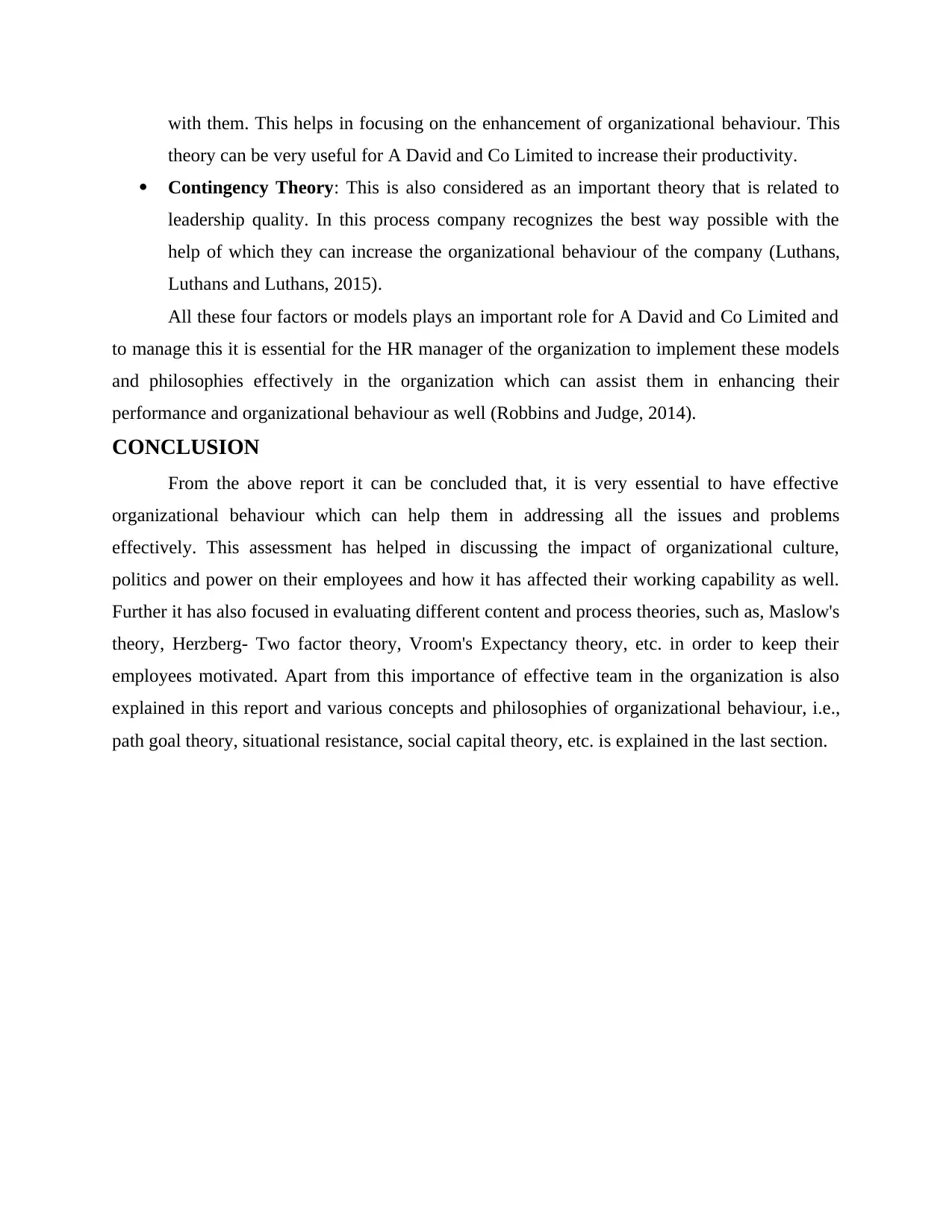
with them. This helps in focusing on the enhancement of organizational behaviour. This
theory can be very useful for A David and Co Limited to increase their productivity.
Contingency Theory: This is also considered as an important theory that is related to
leadership quality. In this process company recognizes the best way possible with the
help of which they can increase the organizational behaviour of the company (Luthans,
Luthans and Luthans, 2015).
All these four factors or models plays an important role for A David and Co Limited and
to manage this it is essential for the HR manager of the organization to implement these models
and philosophies effectively in the organization which can assist them in enhancing their
performance and organizational behaviour as well (Robbins and Judge, 2014).
CONCLUSION
From the above report it can be concluded that, it is very essential to have effective
organizational behaviour which can help them in addressing all the issues and problems
effectively. This assessment has helped in discussing the impact of organizational culture,
politics and power on their employees and how it has affected their working capability as well.
Further it has also focused in evaluating different content and process theories, such as, Maslow's
theory, Herzberg- Two factor theory, Vroom's Expectancy theory, etc. in order to keep their
employees motivated. Apart from this importance of effective team in the organization is also
explained in this report and various concepts and philosophies of organizational behaviour, i.e.,
path goal theory, situational resistance, social capital theory, etc. is explained in the last section.
theory can be very useful for A David and Co Limited to increase their productivity.
Contingency Theory: This is also considered as an important theory that is related to
leadership quality. In this process company recognizes the best way possible with the
help of which they can increase the organizational behaviour of the company (Luthans,
Luthans and Luthans, 2015).
All these four factors or models plays an important role for A David and Co Limited and
to manage this it is essential for the HR manager of the organization to implement these models
and philosophies effectively in the organization which can assist them in enhancing their
performance and organizational behaviour as well (Robbins and Judge, 2014).
CONCLUSION
From the above report it can be concluded that, it is very essential to have effective
organizational behaviour which can help them in addressing all the issues and problems
effectively. This assessment has helped in discussing the impact of organizational culture,
politics and power on their employees and how it has affected their working capability as well.
Further it has also focused in evaluating different content and process theories, such as, Maslow's
theory, Herzberg- Two factor theory, Vroom's Expectancy theory, etc. in order to keep their
employees motivated. Apart from this importance of effective team in the organization is also
explained in this report and various concepts and philosophies of organizational behaviour, i.e.,
path goal theory, situational resistance, social capital theory, etc. is explained in the last section.
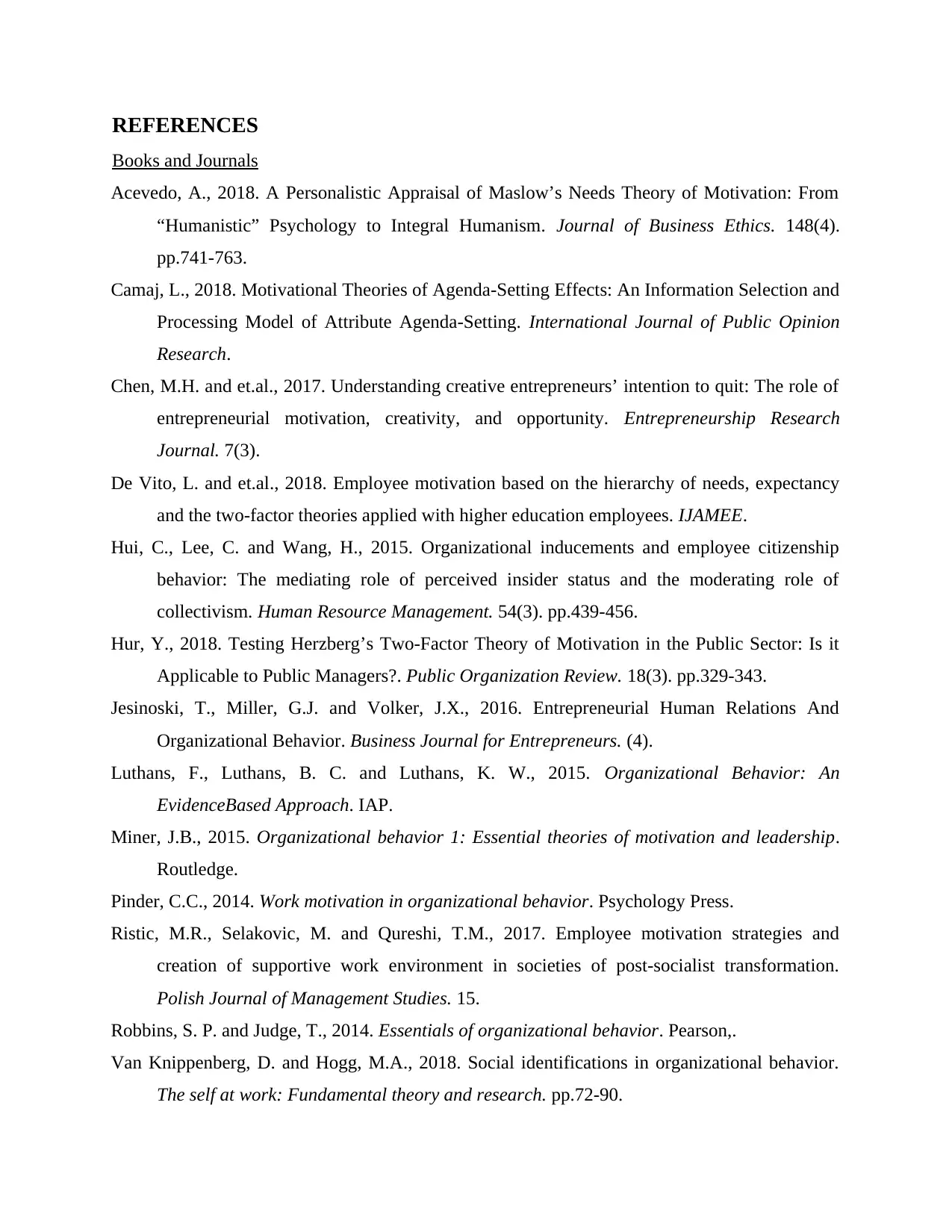
REFERENCES
Books and Journals
Acevedo, A., 2018. A Personalistic Appraisal of Maslow’s Needs Theory of Motivation: From
“Humanistic” Psychology to Integral Humanism. Journal of Business Ethics. 148(4).
pp.741-763.
Camaj, L., 2018. Motivational Theories of Agenda-Setting Effects: An Information Selection and
Processing Model of Attribute Agenda-Setting. International Journal of Public Opinion
Research.
Chen, M.H. and et.al., 2017. Understanding creative entrepreneurs’ intention to quit: The role of
entrepreneurial motivation, creativity, and opportunity. Entrepreneurship Research
Journal. 7(3).
De Vito, L. and et.al., 2018. Employee motivation based on the hierarchy of needs, expectancy
and the two-factor theories applied with higher education employees. IJAMEE.
Hui, C., Lee, C. and Wang, H., 2015. Organizational inducements and employee citizenship
behavior: The mediating role of perceived insider status and the moderating role of
collectivism. Human Resource Management. 54(3). pp.439-456.
Hur, Y., 2018. Testing Herzberg’s Two-Factor Theory of Motivation in the Public Sector: Is it
Applicable to Public Managers?. Public Organization Review. 18(3). pp.329-343.
Jesinoski, T., Miller, G.J. and Volker, J.X., 2016. Entrepreneurial Human Relations And
Organizational Behavior. Business Journal for Entrepreneurs. (4).
Luthans, F., Luthans, B. C. and Luthans, K. W., 2015. Organizational Behavior: An
EvidenceBased Approach. IAP.
Miner, J.B., 2015. Organizational behavior 1: Essential theories of motivation and leadership.
Routledge.
Pinder, C.C., 2014. Work motivation in organizational behavior. Psychology Press.
Ristic, M.R., Selakovic, M. and Qureshi, T.M., 2017. Employee motivation strategies and
creation of supportive work environment in societies of post-socialist transformation.
Polish Journal of Management Studies. 15.
Robbins, S. P. and Judge, T., 2014. Essentials of organizational behavior. Pearson,.
Van Knippenberg, D. and Hogg, M.A., 2018. Social identifications in organizational behavior.
The self at work: Fundamental theory and research. pp.72-90.
Books and Journals
Acevedo, A., 2018. A Personalistic Appraisal of Maslow’s Needs Theory of Motivation: From
“Humanistic” Psychology to Integral Humanism. Journal of Business Ethics. 148(4).
pp.741-763.
Camaj, L., 2018. Motivational Theories of Agenda-Setting Effects: An Information Selection and
Processing Model of Attribute Agenda-Setting. International Journal of Public Opinion
Research.
Chen, M.H. and et.al., 2017. Understanding creative entrepreneurs’ intention to quit: The role of
entrepreneurial motivation, creativity, and opportunity. Entrepreneurship Research
Journal. 7(3).
De Vito, L. and et.al., 2018. Employee motivation based on the hierarchy of needs, expectancy
and the two-factor theories applied with higher education employees. IJAMEE.
Hui, C., Lee, C. and Wang, H., 2015. Organizational inducements and employee citizenship
behavior: The mediating role of perceived insider status and the moderating role of
collectivism. Human Resource Management. 54(3). pp.439-456.
Hur, Y., 2018. Testing Herzberg’s Two-Factor Theory of Motivation in the Public Sector: Is it
Applicable to Public Managers?. Public Organization Review. 18(3). pp.329-343.
Jesinoski, T., Miller, G.J. and Volker, J.X., 2016. Entrepreneurial Human Relations And
Organizational Behavior. Business Journal for Entrepreneurs. (4).
Luthans, F., Luthans, B. C. and Luthans, K. W., 2015. Organizational Behavior: An
EvidenceBased Approach. IAP.
Miner, J.B., 2015. Organizational behavior 1: Essential theories of motivation and leadership.
Routledge.
Pinder, C.C., 2014. Work motivation in organizational behavior. Psychology Press.
Ristic, M.R., Selakovic, M. and Qureshi, T.M., 2017. Employee motivation strategies and
creation of supportive work environment in societies of post-socialist transformation.
Polish Journal of Management Studies. 15.
Robbins, S. P. and Judge, T., 2014. Essentials of organizational behavior. Pearson,.
Van Knippenberg, D. and Hogg, M.A., 2018. Social identifications in organizational behavior.
The self at work: Fundamental theory and research. pp.72-90.
Secure Best Marks with AI Grader
Need help grading? Try our AI Grader for instant feedback on your assignments.
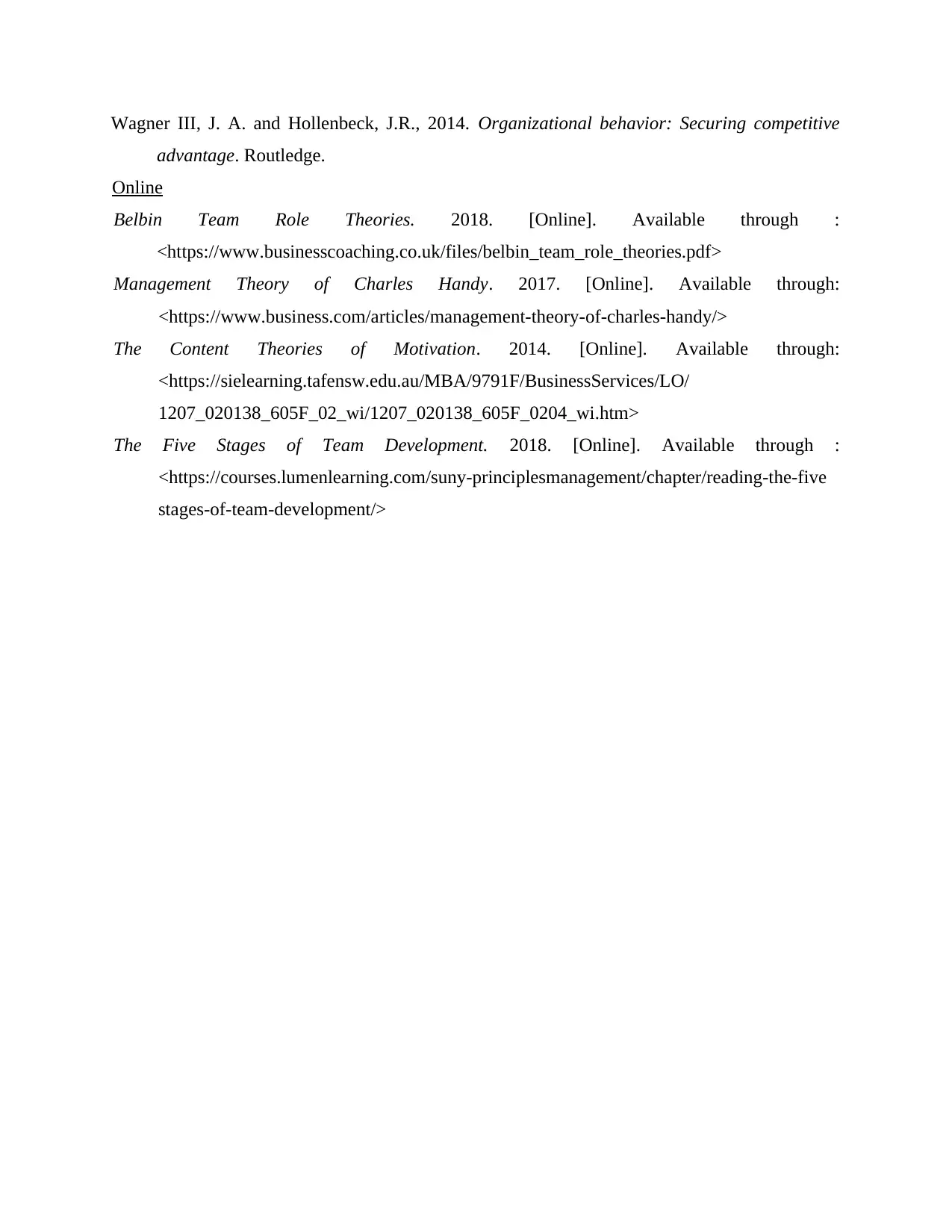
Wagner III, J. A. and Hollenbeck, J.R., 2014. Organizational behavior: Securing competitive
advantage. Routledge.
Online
Belbin Team Role Theories. 2018. [Online]. Available through :
<https://www.businesscoaching.co.uk/files/belbin_team_role_theories.pdf>
Management Theory of Charles Handy. 2017. [Online]. Available through:
<https://www.business.com/articles/management-theory-of-charles-handy/>
The Content Theories of Motivation. 2014. [Online]. Available through:
<https://sielearning.tafensw.edu.au/MBA/9791F/BusinessServices/LO/
1207_020138_605F_02_wi/1207_020138_605F_0204_wi.htm>
The Five Stages of Team Development. 2018. [Online]. Available through :
<https://courses.lumenlearning.com/suny-principlesmanagement/chapter/reading-the-five
stages-of-team-development/>
advantage. Routledge.
Online
Belbin Team Role Theories. 2018. [Online]. Available through :
<https://www.businesscoaching.co.uk/files/belbin_team_role_theories.pdf>
Management Theory of Charles Handy. 2017. [Online]. Available through:
<https://www.business.com/articles/management-theory-of-charles-handy/>
The Content Theories of Motivation. 2014. [Online]. Available through:
<https://sielearning.tafensw.edu.au/MBA/9791F/BusinessServices/LO/
1207_020138_605F_02_wi/1207_020138_605F_0204_wi.htm>
The Five Stages of Team Development. 2018. [Online]. Available through :
<https://courses.lumenlearning.com/suny-principlesmanagement/chapter/reading-the-five
stages-of-team-development/>
1 out of 17
Related Documents
Your All-in-One AI-Powered Toolkit for Academic Success.
+13062052269
info@desklib.com
Available 24*7 on WhatsApp / Email
![[object Object]](/_next/static/media/star-bottom.7253800d.svg)
Unlock your academic potential
© 2024 | Zucol Services PVT LTD | All rights reserved.





